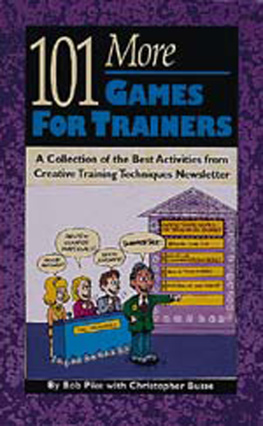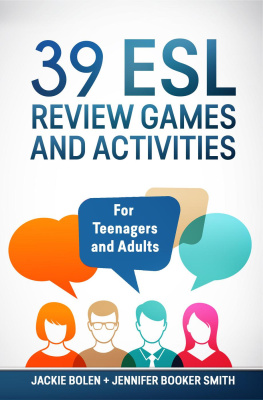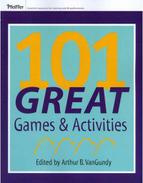
Copyright 1995, 2004 by Bob Pike and Lakewood Publications
All rights reserved. Any reproduction in any media of the materials that appear in this book without written permission from HRD Press is a violation of copyright law.
Published by: | HRD Press, Inc. 22 |
Amherst Road |
Amherst, MA 01002 |
1-800-822-2801 (U.S. and Canada) |
413-253-3488 |
413-253-3490 (fax) |
www.hrdpress.com |
ISBN 0-943210-44-5
Foreword
T his book, 101 Games for Trainers, is one in a series drawn from the best content of Creative Training Techniques Newsletter. The newsletter was conceived in 1988 by editor and internationally known trainer Bob Pike to be a one-stop resource of practical how-tos for trainers. The idea was (and still is) to provide timely tips, techniques, and strategies that help trainers with the special tasks they perform daily.
When the newsletter began, it was largely fueled by Bobs 20 years of experience in the field and by the best ideas shared by the trainers (more than 50,000 in all) who had attended his Creative Training Techniques seminars. As the newsletter grew in popularity, it also began to draw on ideas submitted by its readers. Today, the newsletter continues to search out creative approaches from the more than 200 seminars Bob and the other Creative Training Techniques trainers conduct every year, and from the more than 10,000 newsletter readers.
But no matter where the insights originate, the goal of the newsletter remains the same: To provide trainers a cafeteria of ideas they can quickly absorb, choosing those that best suit their special needs.
As stated earlier, this series of books represents the best ideas from Creative Training Techniques Newsletters seven years of publication. It is our hope that weve created a valuable resource youll come back to again and again to help address the unique challenges you face daily in your role as a trainer.
Sincerely,
The Editors
Introduction

L ike it or not, the age of entertainment in which we live demands that classroom trainers must work hard to capture and hold the interest of participants. If we dont, we run the risk of being passed by in favor of sexier learning methods, such as high-tech computer- or video-based training.
Fortunately, trainers have long known that one of the best ways to entertain and engage adult learners is to encourage them to play games in the classroom. And one advantage we have over any of the high-tech mediums that are capturing the attention of cyber-trainees is that were able to adapt the courses and the games we offer to match precisely the needs of our audience. We can assess participants, decide what kind of exercise is appropriate (and when its appropriate), and use games that will ensure that trainees are entertained and course material is retained.
Thats where 101 More Games for Trainers comes in. Carefully selected and properly implemented, the exercises in this new volume (a companion to the earlier 101 Games for Trainers) can help you actively involve trainees in course openers, bring a weary group back to life, develop communication skills, promote teamwork, lead an audience through a spirited review session, or address the special concerns of certain topical courses.
A brief description of its purpose is provided with each exercise, as well as a reference for the amount of time the exercise will take, the ideal group size for the exercise, and a checklist of the materials youll need to make the exercise happen. And because these represent the best of the ideas collected in Creative Training Techniques Newsletter, you know theyve been successfully field tested all over the world by trainers just like you.
Defining the Categories
The exercises in this book fall into one or more of these six categories. Just below the title of each exercise, youll find a listing of these six categories. The small checkmarks beside each of the categories serve as guides for where best to use the exercise.
Please remember, however, that these are only suggestions. With the right amount of imagination, the exercises here can be adapted to suit almost any training need.

Openers
These exercises, commonly known as ice breakers, serve as vehicles for getting participants to introduce themselves or for putting trainees into the right frame of mind for the coming session.
These exercises might vary according to the type of training being conducted, how big the group is, and how well the group members know each other.
Also keep in mind the Law of Primacy: People remember best what we do first, so choose your openers carefully. (To be honest, nearly all of the exercises here could be adapted as some form of opener.)
Energizers
Designed to involve a group actively, these mid-course exercises are best used during the infamous mid-afternoon slump or anytime you feel a groups attention might be waning.

Often, these games take the form of energetic review sessions or stimulating brainteasers, or even a physical activity that gets people up and moving. The secret here is that these exercises arent always planned.
The best strategy in developing a course is to have a handful of relevant energizers ready to go at a moments notice and implement one when you see attention begin to slip.

Communication
Use these exercises to make a point to trainees about the importance of communication, or to show where certain communication skills need improvement. Exercises that help enhance listening skills also fall into this category. As with Openers, a great many of the activities in this book could easily be adapted to make a point about communication skills, depending on how you position them.
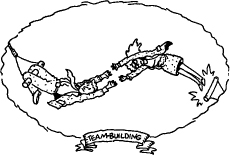
Team-building
The purpose of these exercises is to help improve the relationship of individuals within a group either a specific work group or simply a small group formed during your training session. These exercises are extremely challenging for trainers because they call for participants to work independently in small groups (usually solving some sort of problem) for periods of time that exceed other types of exercises. Your challenge is to keep things moving and to monitor closely the progress of the groups.
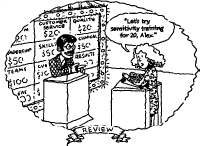
Review
The last words any group of trainees wants to hear are, Okay, lets review. To keep participants from completely tuning out, these exercises often help disguise a review session as a light, interactive competition.
Next page
